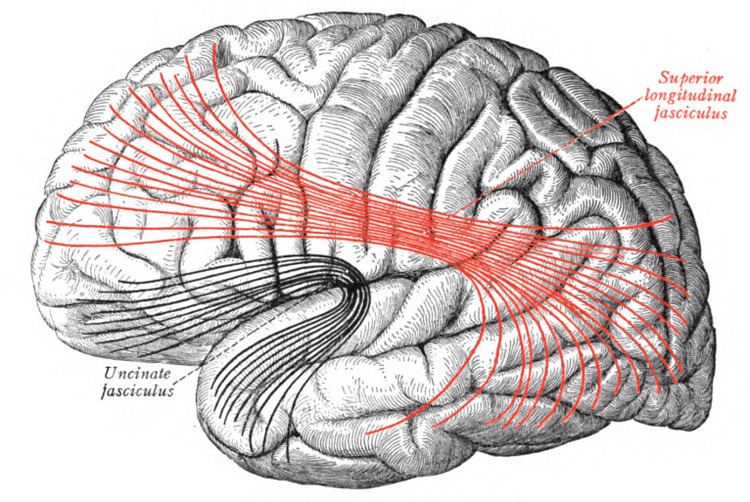NeuroNames ancil-537 TA A14.1.09.557 | Dorlands/Elsevier f_03/ FMA 77631 | |
 | ||
Latin fasciculus longitudinalis superior cerebri | ||
The superior longitudinal fasciculus (SLF) is an association fiber tract that is composed of four separate components. It is present in both hemispheres and can be found lateral to the centrum ovale and connects the frontal, occipital, parietal, and temporal lobes. These bundles of axon tracts pass from the frontal lobe through the operculum to the posterior end of the lateral sulcus where they either radiate to and synapse on neurons in the occipital lobe or turn downward and forward around the putamen and then radiate to and synapse on neurons in anterior portions of the temporal lobe.
Contents
The SLF is composed of four distinct components SLF I, SLF II, SLF III, and the arcuate fasciculus (AF). In humans, these four components are bundled together although they are functionally separate. In non-human primates, the SLF and AF are anatomically separate and have separate trajectories.
SLF I
SLF I is the dorsal component and originates in the superior and medial parietal cortex, passes around the cingulate sulcus and in the superior parietal and frontal white matter, and terminates in the dorsal and medial cortex of the frontal lobe (Brodmann 6, 8, and 9) and in the supplementary motor cortex (M II).
SLF I connects to the superior parietal cortex which encodes locations of body parts in a body-centric coordinate system and with M II and dorsal premotor cortex. This suggests the SLF I is involved with regulating motor behavior, especially conditional associative tasks which select among competing motor tasks based on conditional rules.
SLF II
SLF II is the major component of SLF and originates in the caudal-inferior parietal cortex and terminates in the dorsolateral prefrontal cortex (Brodmann 6, 8 and 46).
SLF II connects to the caudal inferior parietal cortex which controls spatial attention and visual and oculomotor functions. This suggests the SLF II provides the prefrontal cortex with parietal cortex information regarding perception of visual space. Since these bundles are bi-directional, working memory (Brodmann 46) in the prefrontal cortex may provide the parietal cortex with information to focus spatial attention and regulate selection and retrieval of spatial information.
SLF III
SLF III is the ventral component and originates in the supramarginal gyrus (rostral portion of the inferior parietal lobe) and terminates in the ventral premotor and prefrontal cortex (Brodmann 6, 44, and 46).
SLF III connects the rostral inferior parietal cortex which receives information from the ventral precentral gyrus. This suggests that the SLF III transfers somatosensory information, such as language articulation, between the ventral premotor cortex, Brodmann 44 (pars opercularis), the supramarginal gyrus (Brodmann 40), and the laterial inferior prefrontal cortex working memory (Brodmann 46).
Arcuate fasciculus
The arcuate fasciculus originates in the caudal area of the superior temporal gyrus and passes next to the neurons of SLF II above the Sylvian fissure and insula in non-human primates. In humans, neurons that originate from the caudal superior temporal gyrus and the superior temporal sulcus pass around the caudal Sylvian fissure and along with the SLF bundle and terminate in the dorsal prefrontal cortex (Brodmann areas 8 and 46).
The arcuate fasciculus connects the superior temporal gyrus (Tpt) with the dorsal prefrontal cortex which suggests auditory information is transmitted between those two areas of cortex.
